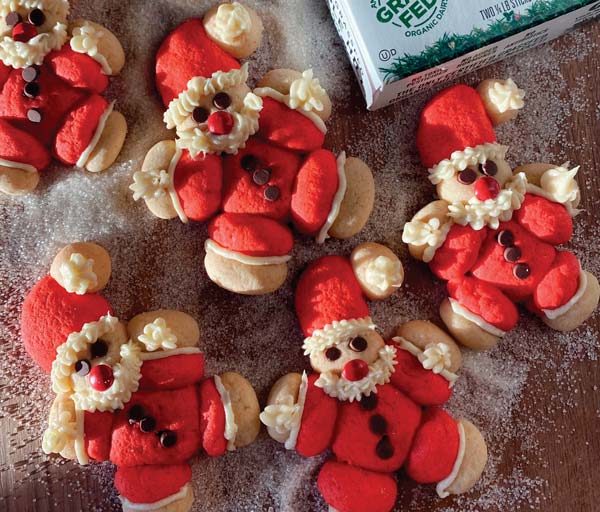Lifestyle
For the Birds: Feed ’em in Fall to Welcome Them Back in Winter

(Joan Casanova) Humans aren’t the only ones who look forward to autumn harvest. Fall brings a bounty of natural foods for our feathered friends, too. But while they’re feasting on fall’s cornucopia of delicacies, birds are also planning ahead, taking note of yards with bird feeders that can help them weather winter’s cold.
Feeding the Birds
Many of birds’ favorite foods are actually more abundant in fall. Summer weeds ripen with seeds by October. Many berries only begin to emerge in late summer or early winter, and insects are plentiful. You may think there’s no need to feed birds during the fall, but if you want them to find your home in winter, start feeding in autumn.
The birds who visit feeders in fall are scouting, becoming familiar with feeding stations and making decisions on which backyards they’ll visit this winter. The feed you put out in fall lets birds know they’ll be welcomed and fed in your backyard when seriously cold weather arrives – and they no longer have the luxury of exploring for food.
Winter weather is hard on birds. Their calorie requirements increase, food becomes hard to find, snow covers up seeds and ice storms seal away tree buds and wild fruits. Tiny birds must eat one-third to three-quarters of their weight each day. When temperatures dip below zero, easy meals at a feeder can mean the difference between life and death.
An important rule of fall and winter feeding is to be prepared. By stocking up now on premium bird seeds and feed, bird lovers can help secure a wholesome food source without having to brave stormy weather.
It’s important to stock your feeders with high-quality foods that provide birds with the most fat, nutrients and energy. Look for a feed like Cole’s that packs nutrition, preserves freshness and gives you the most feed for your dollar. For example, Cole’s Wild Bird Products’ Oil Sunflower is more than 99% pure and cleaned four times to ensure there are more seeds and fewer sticks in each bag. Feed is also nitrogen-purge packaged, just like potato chips, to ensure freshness and insect-free feed.
In addition to seed, serve up some suet either in the form of Suet cakes for non-seed eating birds or suet mixed with seed. Consider Cole’s Nutberry Suet, which is a seed blend mix of premium fruits, preferred nuts, nutritious insect suet kibbles and whole-kernel sunflower meats that appeals to fruit and insect-loving songbirds. Or try Suet Kibbles, bursting with berry flavor and loaded with energy for increased stamina. These feed choices provide fat and a high-protein energy source to assist wild birds in weathering winter and may actually boost their chance of survival.
Just as birds need food year-round, they also look for water. This can be tricky in regions where water spends the winter as ice, but bird lovers can still help in a few ways. Experts suggest leaving icicles on the eaves to provide a regular source of water for birds that drink drops as the icicles melt. Birds are drawn to running water sounds, so spritzers or small fountains are beneficial. In the winter, try using quality bird bath heaters to keep water from freezing, plus they’re more convenient than setting out water every day.
Don’t worry about the birds if you must leave home for a while in winter. Birds are familiar with food sources disappearing. It might take them a while to rediscover your feeders when you return, but they’ll be back, grateful for your assistance.
For more ideas to help birds eat well through winter, and to learn about more feed choices, visit coleswildbird.com.
Photos courtesy of Cole’s Wild Bird Products
SOURCE:
Cole’s Wild Bird Products
Our Lifestyle section on STM Daily News is a hub of inspiration and practical information, offering a range of articles that touch on various aspects of daily life. From tips on family finances to guides for maintaining health and wellness, we strive to empower our readers with knowledge and resources to enhance their lifestyles. Whether you’re seeking outdoor activity ideas, fashion trends, or travel recommendations, our lifestyle section has got you covered. Visit us today at https://stmdailynews.com/category/lifestyle/ and embark on a journey of discovery and self-improvement.
Discover more from Daily News
Subscribe to get the latest posts sent to your email.
Family
5 Tips to Pull Off Holiday Hosting
With stay-at-home holidays a thing of the past for many families, they’re now busy preparing for full-blown celebrations. The return of traditional festivities brings seemingly never-ending to-do lists and pressure to be the perfect host.
Last Updated on December 17, 2025 by Daily News Staff
(Family Features) With stay-at-home holidays a thing of the past for many families, they’re now busy preparing for full-blown celebrations. The return of traditional festivities brings seemingly never-ending to-do lists and pressure to be the perfect host.
From mastering a mouthwatering menu and donning your home with decadent decor to ensuring guests enjoy the evening to the fullest, hosting duties bring plenty of responsibilities. This year, though, you can avoid those anxious feelings with some preparation ahead of the big day.
To help pull off a sensational seasonal soiree, consider these tips from the entertaining experts at Sun-Maid to make the holidays brighter and more manageable so you can navigate the stresses of hosting.
Invite Others to Share Favorite Traditions
Especially with stay-at-home holidays in recent years, some friends and family members may have developed their own special traditions from new recipes and foods to seasonal games and activities. Inviting your guests to bring or share something that represents their favorite part of the holidays can help everyone feel welcome.
Take Time for Yourself
Remember to make time for yourself so you can enjoy the fruits of your labor right alongside guests. The busyness of this time of year can add stress but reflecting on the true meaning of the season and reveling in your favorite parts of the holidays can help you avoid feeling overwhelmed.
Add New Ingredients to Your Menu
While pairing this year’s turkey or ham with the classics provides comfort and calls to mind holiday memories of the past, cooking with new ingredients and adding fresh recipes to the menu can put a fun spin on the season and maybe even create your own traditions to carry forward.
For example, baking with an option like Sun-Maid Raisins provides a whole fruit option with zero grams of added sugars per 1/4-cup serving. They’re an easy, better-for-you substitution to reduce overall sugar intake without compromising flavor or texture when compared with dried cranberries, which contain 27 grams of added sugars per 1/4-cup serving. The natural sugars of raisins make them a versatile, useful addition to a wide variety of holiday-worthy dishes.
Hop On Hot Food Trends
One of this year’s most popular trends in the kitchen is food boards, a fun and easy way to elevate flavor while incorporating favorites like cured meats, cold cuts, cheese slices and cubes, dips, nuts and more. Plus, you can keep your board balanced with nutritious items like vegetables and fruit, such as raisins, which provide sweet flavor without the added sugars.
A Time for Truce
Gathering for the holidays is about coming together with loved ones, family, friends and neighbors – and pulling it off means catering to everyone’s needs and wants. It’s a time for compromises and truces. To help add a little extra spark this year, try incorporating a theme to the party or coordinate fun activities and games that can be enjoyed by all. For example, holiday-themed charades, a seasonal “name that tune” game and gift exchanges all give guests ways to get in on the excitement.
To find more holiday entertaining inspiration and recipe ideas, visit SunMaid.com/PullOffTheHolidays .
Photos courtesy of Getty Images
SOURCE:
Sun-Maid Raisins
Discover more from Daily News
Subscribe to get the latest posts sent to your email.
Food and Beverage
Unwrap the Holidays: Whataburger Launches 12 Days of Whatacheer With Daily App Deals
Celebrate the holidays with Whataburger’s 12 Days of Whatacheer! Discover daily in-app deals, exclusive to Rewards members, from December 12–23. Unwrap new menu favorites, BOGO offers, and festive savings—only on the Whataburger App.
12 Days of Whatacheer: Festive Deals for Rewards Members
How It Works
- Who: Whataburger Rewards members (sign up in the app if you’re not already!)
- When: December 12–23, with a new offer every day
- How: Open the Whataburger App, claim the day’s deal, and enjoy with your next order
Holiday-themed graphic reading ‘12 Days of WhataCheer’ on a red background with white dots. Below the text are images of Whataburger menu items: a Cinnamon Roll, Onion Rings, a Whataburger, a Whatafresher, a Honey Butter Chicken Biscuit, and a Strawberry Shake.
Why Join the Whataburger Rewards Fun?
Get Started
Discover more from Daily News
Subscribe to get the latest posts sent to your email.
Recipe of the Week
Holiday Desserts Just Got a Dairy-Forward Upgrade
Holiday Desserts: From festive cookies to indulgent dips, these delicious desserts bring people together to create memories that will last a lifetime. If you’re looking to impress guests, Santa Cookies are the ultimate treat. For a unique twist, try Gingerbread Dip, featuring vanilla Greek yogurt made with 100% grass-fed organic milk.
Last Updated on December 17, 2025 by Rod Washington

Holiday Desserts Just Got a Dairy-Forward Upgrade
(Family Features) Holiday desserts set the stage for seasonal delight and add a touch of joy to gatherings. From festive cookies to indulgent dips, these delicious desserts bring people together to create memories that will last a lifetime. If you’re looking to impress guests, Santa Cookies are the ultimate treat. Made with Maple Hill Salted Butter, they’re rich, soft and full of festive spirit. For a unique twist, try Gingerbread Dip, featuring vanilla Greek yogurt made with 100% grass-fed organic milk. Whether you’re hosting or deciding what to bring to the potluck, Maple Hill’s 100% grass-fed organic dairy makes it easy to whip up desserts that are as wholesome as they are delicious. Rich in nutrients and free from GMOs, hormones and antibiotics, each product comes from farms that prioritize regenerative practices as nature intended. With a 40% healthier ratio of omega 3:6 and 40% higher levels of CLA fatty acids compared to traditional organic dairy, you can feel good about sweet treats at the holiday table. To find more recipes, visit MapleHill.com.
Santa Cookies
Yield: 14 cookies- 1 cup (2 sticks) Maple Hill Salted Butter, at room temperature
- 1/2 cup brown sugar
- 1 tablespoon vanilla extract
- 1 large egg, at room temperature
- 2 1/4 cups all-purpose flour
- 1/4 teaspoon salt
- 1 teaspoon red food coloring
- mini chocolate chips
- mini red chocolate-coated candies
- 1/2 cup (1 stick) Maple Hill Salted Butter, at room temperature
- 4 ounces cream cheese, at room temperature
- 1 teaspoon vanilla extract
- 2 1/2 cups powdered sugar
- Preheat oven to 350 F and line two baking sheets with parchment paper.
- In large mixing bowl, beat butter, sugar and vanilla until light and fluffy. Add egg and beat until combined. Add flour and salt; mix until dough begins to form ball.
- Remove 1 cup dough and set aside. Add red food coloring to remaining dough.
- From red cookie dough, make one 1-inch ball and five 1/2-inch balls. From plain cookie dough, make one 3/4-inch ball and five 1/4-inch balls.
- On prepared baking sheet, place red 1-inch ball and gently flatten until 1/2-inch thick. Attach four red 1/2-inch balls for arms and legs. Attach plain 3/4-inch ball for head and gently flatten until 1/2-inch thick. Attach plain 1/4-inch balls for hands and feet. Shape remaining red 1/2-inch ball into triangle for hat and attach. Repeat with remaining dough, arranging cookies 2 inches apart on baking sheet. Add chocolate candies for eyes and buttons.
- Bake 12-15 minutes, or until lightly golden.
- To make frosting: In medium bowl, beat butter and cream cheese until light and fluffy, about 3 minutes. Add vanilla and powdered sugar; mix until combined.
- To decorate: Place half of frosting in piping bag with small tip to line Santa’s arms and legs. Place other half in second piping bag with small star tip to add Santa’s beard, hat and hands. Put small dot of icing between eyes and beard and place red mini chocolate-coated candy on face for nose.

Gingerbread Dip
Servings: 8-12- 4 ounces cream cheese, at room temperature
- 1/4 cup brown sugar
- 1/4 cup powdered sugar
- 3 tablespoons molasses
- 1 container (16 ounces) Maple Hill Vanilla Greek Yogurt
- 1 teaspoon ground ginger
- 1 teaspoon ground cinnamon
- 1 teaspoon ground nutmeg
- 2 cups whipped cream
- graham crackers
- fruit
- In medium bowl using electric mixer on medium speed, beat cream cheese and sugars about 1 minute. Add molasses and mix until combined.
- Add Greek yogurt, ginger, cinnamon and nutmeg; beat until combined. Fold in whipped cream and mix until fully incorporated. Refrigerate 1 hour before serving or overnight.
- Serve with graham crackers and fruit.
At our core, we at STM Daily News, strive to keep you informed and inspired with the freshest content on all things food and beverage. From mouthwatering recipes to intriguing articles, we’re here to satisfy your appetite for culinary knowledge.
Visit our Food & Drink section to get the latest on Foodie News and recipes, offering a delightful blend of culinary inspiration and gastronomic trends to elevate your dining experience. https://stmdailynews.com/food-and-drink/
Discover more from Daily News
Subscribe to get the latest posts sent to your email.

